Large displacement analysis is a fundamental simulation technique used by design engineers across a variety of engineering disciples.
For speaker design, large displacement analysis is an essential tool to ensure that speaker surrounds and suspensions (also known as a speaker spider) can withstand the large excursions placed on them, are stiff enough to keep the voice coil in the magnetic gap and avoid distortion by keeping the speaker operating within a normal range.
As a general rule, a large displacement analysis is needed when the displacement of components is large enough to impact the stiffness of the components significantly. A large displacement analysis assumes stiffness will change with loading.
In this article, I will explain how acoustic engineers and speaker designers use large displacement analysis used when designing speaker parts such as speaker surrounds and suspensions.
I will cover:
- What is large displacement analysis?
- How is large displacement analysis used for speaker design?
- How to complete a large displacement analysis of a speaker suspension
- How to read results of a large displacement analysis of a speaker suspension
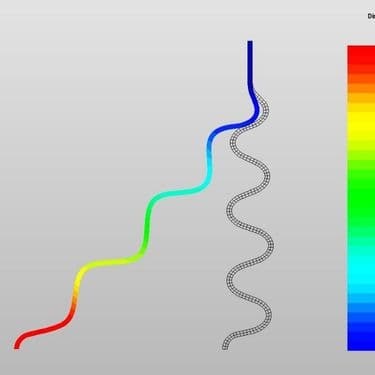
What is Large Displacement Analysis?
Large displacement analysis (LDA) is a numerical method used to simulate the behaviour of structures subjected to large displacements and rotations.
This is important in the design of speaker drivers, as speaker surrounds and suspensions need to withstand the large displacements caused by the movement of the voice coil.
As well as being used as part of designing a speaker, we commonly use this type of analysis in the design of consumer electronics, automobiles, aerospace vehicles, and medical devices.
How Is Large Displacement Analysis Used For Speaker Design?
The surround and the suspension components of a loudspeaker driver need large displacement analysis to ensure that the design is good and will work within specified operating parameters.
In a speaker, the voice coil is attached to the former, suspension, cone and surround. All these components sit in a speaker chassis (also called the basket).
When an input voltage (i.e. signal) is applied to the speaker, the voice coil will oscillate as it is sitting in the magnetic field of the speaker motor driver, as shown in the following image.
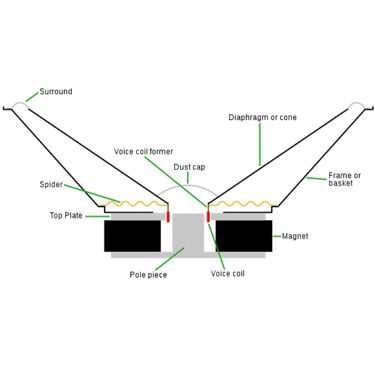
As a result, the suspension, cone, and surround assembly will oscillate to create sound.
The purpose of the suspension and surround is to restrain the voice coil motion and keep the cone operating well with a reasonable restoring force, so the cone can move enough to create an acceptable level of sound, but not so much that it falls flat.
In a perfect world, the suspension and surround will be stiff enough to restore and keep the voice coil in the gap, but soft enough to allow the cone to move freely.
Depending on the size of the speaker, the displacement of the suspension and surround can be very high, with a standard 12″ cone moving around 10mm on average, for example.
We need a large displacement analysis to see how well the stiffness and stress of the suspension and surround materials react to the large displacement of the voice coil and cone.
It helps speaker designs answer the following questions:
- Is my surround and suspension stiff enough to suspend the voice coil in the magnetic gap?
- Is my surround and suspension compliant enough to allow sufficient movement of the voice coil in the magnetic gap?
How To Complete A Large Displacement Analysis Of A Speaker Suspension
The following image is an example of a large displacement analysis of a speaker suspension.
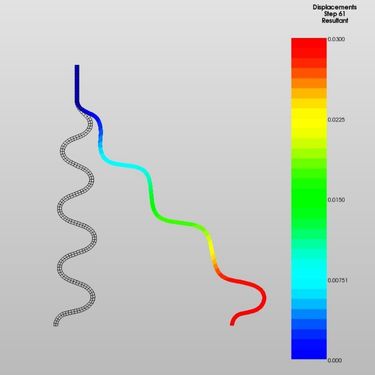
Just like all simulation problems, the suspension must have the following:
1. Boundary Conditions
In this instance, the suspension is clamped where it is attached to the speaker’s chassis.
2. Displacement Condition
We need to tell our simulation software how far we want the suspension to move. In this example, I displaced the suspension by 30mm in the positive and negative direction.
3. Material Properties
Material properties are applied to the suspension.
In order to solve the simulation and view the results, you just need to ensure that the following criteria are set in your simulation model, whichever simulation software package you use.
- You must constrain the suspension model where the suspension is glued to the speaker chassis.
- You must apply the correct material properties to the suspension.
- You must set the part of the suspension that connects to the voice coil to move with a displacement value that is slightly more than what you expect the voice coil to move in reality. This is to include a margin of safety.
How To Read Results Of A Large Displacement Analysis Of A Speaker Suspension
Below is an image of the simulation results of a large displacement analysis of a speaker suspension:

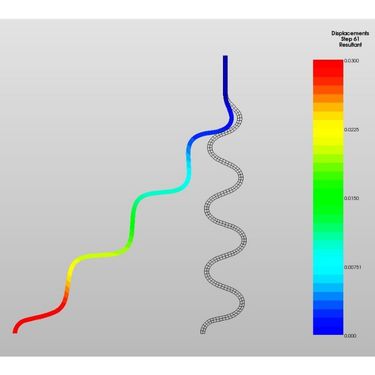
These images show the displacement of the suspension and we can see that the suspension is displaced to 30mm.
What we are really interested in, however, is how the stiffness of the suspension varies over the total displacement.
In a perfect world, we would like the stiffness to be similar in the positive and negative discretion, which will create a perfectly symmetrical speaker that will work well as the voice coil oscillates in the magnetic gap.
The following is a perfect large displacement result of a loudspeaker suspension showing how the stiffness of the suspension changes with the amount of displacement. It is similar in the positive and negative directions, so as the voice coil oscillates and the cone moves, the cone will move linearly up and down with no distortion or too much stress on the suspension.
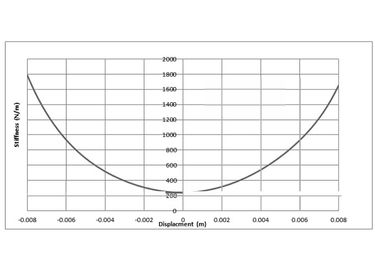
Final Thoughts
A large displacement analysis is a simulation that helps speaker designers understand how well the stiffness and stress of the suspension and surround materials react to the large displacement of the voice coil and cone.
For example, by displacing the suspension by a set amount in both positive and negative directions, we can see how well the material properties of the surround and suspension hold up under stress and how well they restore to hold the voice coil in balance in the magnetic gap.
In a perfect world, we would like the stiffness to be similar in the positive and negative discretion, which will create a perfectly symmetrical speaker that will work well as the voice coil oscillates in the magnetic gap.
